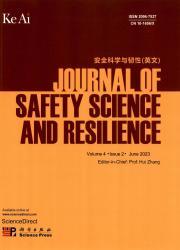Guidance for estimating the blast load from vapour cloud explosions in traffic environments using the multi-energy method
IF 3.4
Q1 PUBLIC, ENVIRONMENTAL & OCCUPATIONAL HEALTH
引用次数: 0
Abstract
The accidental release of a flammable gas on a road can result in a vapour cloud explosion (VCE). Such VCEs generate a blast wave that propagates away from the explosion, potentially damaging nearby structures. The TNO Multi-Energy Method is commonly used for a simplified estimate of the blast load resulting from a VCE. The method characterises the severity and duration of the blast wave using a case-specific strength class and combustion energy (which the method relates to the gas volume of the equivalent blast source). However, no specific guidelines for estimating the strength class in urban roads or related settings (such as carparks) are currently available in the literature. This makes implementing the method in such scenarios challenging and imprecise. The authors’ work used computational fluid dynamics (CFD) to evaluate multiple gas explosion scenarios and proposed recommendations for determining the strength class and gas volume at the blast source. These scenarios comprised a group of vehicles engulfed by a stoichiometric propane-air cloud. It was concluded that the strength class could be reasonably estimated based on the number of vehicles in the transverse direction. Furthermore, the guidance for estimating the gas volume at the equivalent blast source was based on the critical gas volume, after which no further enhancement of overpressure was obtained. The recommendations were implemented in several scenarios and compared with corresponding CFD analyses. The results showed very good agreement for predicting impulse. Predicting overpressure was affected by the inherent asymmetry of the scenarios, although it was possible to achieve acceptable and conservative results.
用多能法估计交通环境中蒸汽云爆炸爆炸载荷的导则
可燃气体在道路上的意外释放会导致蒸汽云爆炸(VCE)。这种vce产生的冲击波会从爆炸处传播出去,可能会破坏附近的建筑物。TNO多能法通常用于对VCE产生的爆炸载荷的简化估计。该方法使用特定情况的强度等级和燃烧能量(该方法与等效爆炸源的气体体积有关)来表征爆炸波的严重性和持续时间。然而,目前文献中没有具体的指导方针来估计城市道路或相关环境(如停车场)的强度等级。这使得在这种情况下实现该方法具有挑战性且不精确。作者的工作使用计算流体动力学(CFD)来评估多种气体爆炸情景,并提出了确定爆炸源强度等级和气体体积的建议。这些场景包括一组被化学计量丙烷空气云吞没的车辆。结果表明,可以根据横向车辆的数量合理地估计其强度等级。在等效爆炸源处,气体体积的估计以临界气体体积为指导,超过临界气体体积后,超压没有进一步提高。这些建议在几个场景中实施,并与相应的CFD分析进行了比较。结果表明,对冲量的预测具有很好的一致性。尽管有可能获得可接受的、保守的结果,但超压预测受到情景固有的不对称性的影响。
本文章由计算机程序翻译,如有差异,请以英文原文为准。
求助全文
约1分钟内获得全文
求助全文
来源期刊

安全科学与韧性(英文)
Management Science and Operations Research, Safety, Risk, Reliability and Quality, Safety Research
CiteScore
8.70
自引率
0.00%
发文量
0
审稿时长
72 days
 求助内容:
求助内容: 应助结果提醒方式:
应助结果提醒方式:


